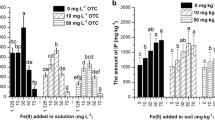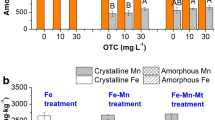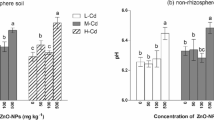Abstract
Purpose
It has been reported the bioaccumulation of γ-ferric oxide nanoparticles (Fe2O3 NPs) or oxytetracycline (OTC) in crops. However, there have been little references investigating their uptake and bioaccumulation in crops after the combined exposure. The present study focused on Fe2O3 NPs and OTC accumulation on root surface and in the tissues of rice (Oryza sativa L.) seedlings under combined exposure. And, the interactive influence mechanism was also discussed.
Materials and methods
Hydroponic experiments were conducted to investigate the Fe and OTC accumulation on root surface and in rice tissues under individual and combined exposure of Fe2O3 NPs and OTC. The dynamic change of particulate Fe, ionic Fe, and Fe plaque concentrations on root surface was determined under the influence of OTC from Fe2O3 NPs and Fe-EDTA exposure. Fe2+ from Fe-EDTA was selected in order to compare the Fe bioaccumulation from ionic Fe and nanoparticle Fe exposure. Hydrodynamic diameter and ζ-potential of Fe2O3 NPs in solution were investigated when OTC was present or not, and the changes of OTC concentrations were also determined during hydroponic culture. SEM, XRD, and TEM were used to analyze Fe2O3 NP distribution on root surface and inside root under the influence of OTC.
Results and discussion
OTC promoted surface-Fe and shoot-Fe accumulation in Fe2O3 NPs treatments, which was just an opposite result from Fe-EDTA treatments. Upon Fe2O3 NP exposure, Fe plaque was formed through the direct adsorption of NPs on the outside root surface and then incorporated into plaque as its crystalline components. OTC elevated notably surface-Fe accumulation mainly through increasing adsorption and precipitation of Fe2O3 NPs on the root surface due to low repulsive electrostatic interaction between NPs and the root surface after adding OTC. Fe2O3 NPs increased surface-OTC and root-OTC levels. Compared to Fe-EDTA, surface-Fe from NP treatments can hold strongly OTC due to Fe2O3 particle precipitated on root surface with high specific surface area. NPs reduced shoot-OTC under 25 mg L−1 OTC, but not under 100 mg L−1 OTC.
Conclusions
This study clearly demonstrates that Fe/OTC accumulation in rice was always in the order root surface > shoot > root, whether Fe2O3 NPs/OTC was individual or combined exposure. The combined exposure will increase their root surface distribution comparing with individual exposure, and Fe2O3 NPs increased also root-OTC levels, which could pose a potential risk to food safety in subsequent growth of rice.








Similar content being viewed by others
References
Armstrong W (1997) The oxidising activity of roots in waterlogged soils. Physiol Plant 20:920–926
Bao YY, Zhou QX (2015) Temporal changes in horsebean bioavailability and accumulation after removing extractable oxytetracycline fractions in soils. RSC Adv 5:32572–32579
Bao YY, Zhou QX, Guan LZ, Wang YY (2009) Depletion of chlortetracycline during composting of aged and spiked manures. Waste Manag 29(4):1416–1423
Bao YY, Chen Q, Ma W, Zhou QX (2018) Influence of Fe addition on the accumulation of oxytetracycline in rice seedlings (Oryza sativa L.) growing in hydroponic and soil culture. J Soils Sediments 18:1958–1970
Cai F, Ren J, Tao S, Wang X (2016) Uptake, translocation and transformation of antimony in rice (Oryza sativa L.) seedlings. Environ Pollut 209:169–176
Chen CC, Dixon JB, Turners FT (1980) Iron coatings on rice roots morphology and models of development. Soil Sci Soc Am J 44:1113–1119
Figueroa RA, MacKay AA (2005) Sorption of oxytetracycline to iron oxides and iron oxide-rich soils. Environ Sci Technol 39:6664–6671
Geisler-Lee J, Wang Q, Yao Y, Zhang W, Geisler M, Li K, Huang Y, Chen Y, Kolmakov A, Ma X (2013) Phytotoxicity, accumulation and transport of silver nanoparticles by Arabidopsis thaliana. Nanotoxicology 7:323–337
Ghosh S, Jiang W, Mcclements JD, Xing BS (2011) Colloidal stability of magnetic iron oxide nanoparticles: influence of natural organic matter and synthetic polyelectrolytes. Langmuir 27:8036–8043
Gupta UC (1968) Studies on the O-phenanthroline method for determining iron in plant materials. Plant Soil 28(2):298–305
Hu XG, Zhou QX (2013) Health and ecosystem risks of graphene. Chem Rev 113:3815–3835
Hu M, Li FB, Liu CP, Wu WJ (2015) The diversity and abundance of As(III) oxidizers on root iron plaque is critical for arsenic bioavailability to rice. Sci Rep 5:1–10
Khush GS (1997) Origin, dispersal, cultivation and variation of rice. Oryza: from molecule to plant. Springer, Netherlands, pp 25–34
Kulshrestha P, Giese RF, Aga DS (2004) Investigating the molecular interactions of oxytetracycline in clay and organic matter: insights on factors affecting its mobility in soil. Environ Sci Technol 38(15):4097–4105
Lanzl CA, Baltrusaitis J, Cwiertny DM (2012) Dissolution of hematite nanoparticle aggregates: influence of primary particle size, dissolution mechanism, and solution pH. Langmuir 28:15797–15808
Li Y, Wang H, Liu X, Zhao G, Sun Y (2016a) Dissipation kinetics of oxytetracycline, tetracycline, and chlortetracycline residues in soil. Environ Sci Pollut Res 23:13822–13831
Li JL, Hu J, Ma CX, Wang YQ, Wu C, Huang J, Xing BS (2016b) Uptake, translocation and physiological effects of magnetic iron oxide (γ-Fe2O3) nanoparticles in corn (Zea mays L.). Chemosphere 159:326–334
Liu WJ, Zhu YG, Hu Y, Williams PN, Gault AG, Meharg AA, Charnock JM, Smith FA (2006) Arsenic sequestration in iron plaque, its accumulation and speciation in mature rice plants (Oryza Sativa L.). Environ Sci Technol 140:5730–5736
Liu YX, Bao YY, Cai Z, Zhang ZN, Cao PL, Li XQ, Zhou QX (2015) The effect of aging on sequestration and bioaccessibility of oxytetracycline in soils. Environ Sci Pollut Res 22:10425–10433
Liu H, Ma CX, Chen GC, White JC, Wang ZH, Xing BS, Dhankher OP (2017) Titanium dioxide nanoparticles alleviate tetracycline toxicity to Arabidopsis thaliana (L.). ACS Sustain Chem Eng 5:3204–3213
Ma YH, He X, Zhang P, Zhang Z, Guo Z, Tai R, Xu Z, Zhang L, Ding Y, Zhao Y (2011) Phytoxicity and biotransformation of La2O3 nanoparticles in a terrestrial plant cucumber (Cucumissativus). Nanotoxicology 5:743–753
Ma YH, Zhang P, Zhang ZY, He X, Zhang JZ, Ding YY, Zhang J, Zheng LR, Guo Z, Zhang LJ, Chai ZF, Zhao YL (2015) Where does the transformation of precipitated ceria nanoparticles in hydroponic plants take place? Environ Sci Technol 49:10667–10674
Ma CX, Liu H, Chen GC, Zhao Q, Eitzer B, Wang ZH, Cai WJ, Newman LA, White JC, Dhankher OP (2017) Effects of titanium oxide nanoparticles on tetracycline accumulation and toxicity in Oryza sativa (L.). Environ Sci Nano 4:1827–1839
Manuel CC, Cristina AE, Remigio PN, Juan CNM, Manuel AE, Esperanza AR, María JFS, Avelino ND (2018) Occurrence of tetracyclines and sulfonamides in manures, agricultural soils and crops from different areas in Galicia (NW Spain). J Clean Prod 197:491–500
Martínez-Fernández D, Barroso D, Komárek M (2016) Root water transport of Helianthus annuus L. under iron oxide nanoparticle exposure. Environ Sci Pollut Res 23:1732–1741
Meychik NR, Yermakov IP (2001) Ion exchange properties of plant root cell walls. Plant Soil 234:181–193
Monica RC, Cremonini R (2009) Nanoparticles and higher plants. Caryologia 62:161–165
Nhan LV, Ma C, Rui Y, Cao W, Deng Y, Liu L, Xing B (2015) The effects of Fe2O3 nanoparticles on physiology and insecticide activity in non-transgenic and Bt-transgenic cotton. Front Plant Soil 6:1263
Pardo T, Martínez-Fernández D, Fuente C, Clemente R, Komáre M, Bernal MP (2016) Maghemite nanoparticles and ferrous sulfate for the stimulation of iron plaque formation and arsenic immobilization in Phragmites australis. Environ Pollut 219:296–304
Parsons JG, Lopez ML, Gonzalez CM, Peralta-Videa JR, Gardea-Torresdey JL (2010) Toxicity and biotransformation of uncoated and coated nickel hydroxide nanoparticles on mesquite plants. Environ Toxicol Chem 29:1146–1154
Qi N, Wang PF, Wang C, Ao YH (2018) Effect of a typical antibiotic (tetracycline) on the aggregation of TiO2 nanoparticles in an aquatic environment. J Hazard Mater 341:187–197
Rubert KF and Pederson JA (2006) Kinetics of Oxytetracycline Reaction with a Hydrous Manganese Oxide. Environ Sci Technol 40:7216–7221
Sebastian A, Nangia A, Prasad MNV (2017) Carbon-bound iron oxide nanoparticles prevent calcium-induced iron deficiency in Oryza sativa L. J Agric Food Chem 65:557–564
Sun JT, Zeng QT, Tsang DCW, Zhu LZ, Li XD (2017) Antibiotics in the agricultural soils from the Yangtze River Delta, China. Chemosphere 189:301–308
Wang H, Yao H, Sun P, Li D, Huang C (2016) Transformation of tetracycline antibiotics and Fe(II) and Fe(III) species induced by their complexation. Environ Sci Technol 50:145–153
Wei RC, He T, Zhang SX, Zhu L, Shang B, Li ZJ, Wang R (2019) Occurrence of seventeen veterinary antibiotics and resistant bacterias in manure-fertilized vegetable farm soil in four provinces of China. Chemosphere 215:234–240
Wu C, Zou Q, Xue SG, Pan WS, Huang L, Hartley W, Mo JY, Wong MH (2016) The effect of silicon on iron plaque formation and arsenic accumulation in rice genotypes with different radial oxygen loss (ROL). Environ Pollut 212:27–33
Zhang P, Ma Y, Zhang Z, He X, Guo Z, Tai R, Ding Y, Zhao Y, Chai Z (2011) Comparative toxicity of nanoparticulate/bulk Yb2O3 and YbCl3 to cucumber (Cucumissativus). Environ Sci Technol 46:1834–1841
Zhang P, Ma YH, Zhang ZY, He X, Zhang J, Guo Z, Tai RZ, Zhao YL, Chai ZF (2012) Biotransformation of ceria nanoparticles in cucumber plants. ACS Nano 6:9943–9950
Zhou QX, Sun FH, Liu R (2005) Joint chemical flushing of soils contaminated with petroleum hydrocarbons. Environ Pollut 31:835–839
Zhu ZJ, Wang HH, Yan B, Zheng H, Jiang Y, Miranda OR, Rotello VM, Xing BS, Vachet RW (2012) Effect of surface charge on the uptake and distribution of gold nanoparticles in four plant species. Environ Sci Technol 46:12391–12398
Acknowledgements
Y.Y. Bao thanks the China Scholarship Council for supporting her study at the University of Massachusetts, Amherst.
Funding
This work is financially supported by the Tianjin Municipal Science and Technology Commission (Grant 16JCZDJC39200) and by National Key R&D Program of China (2018YFD0800303) from China.
Author information
Authors and Affiliations
Corresponding author
Additional information
Responsible editor: Dong-Mei Zhou
Publisher’s note
Springer Nature remains neutral with regard to jurisdictional claims in published maps and institutional affiliations.
Electronic supplementary material
The additional information for dry weight of rice, TEM imaging of rice root, as well as the elimination of OTC in hydroponic solution is presented in the supplementary file.
ESM 1
(DOCX 7127 kb)
Rights and permissions
About this article
Cite this article
Bao, Y., Ma, C., Hu, L. et al. Effect of individual and combined exposure of Fe2O3 nanoparticles and oxytetracycline on their bioaccumulation by rice (Oryza sativa L.). J Soils Sediments 19, 2459–2471 (2019). https://doi.org/10.1007/s11368-018-2216-8
Received:
Accepted:
Published:
Issue Date:
DOI: https://doi.org/10.1007/s11368-018-2216-8




